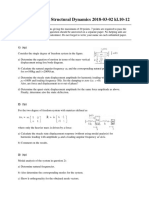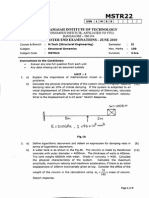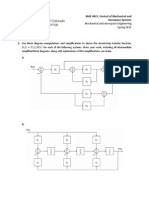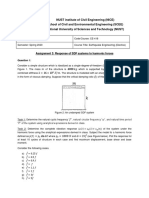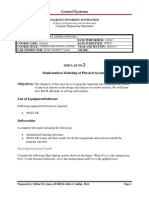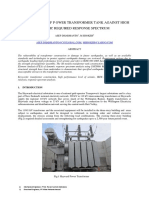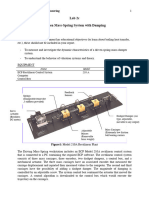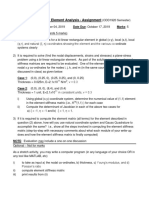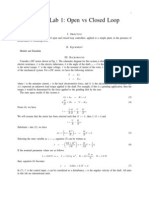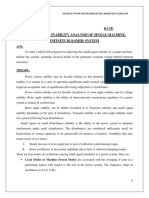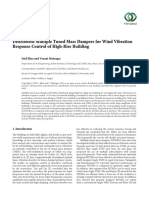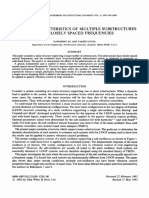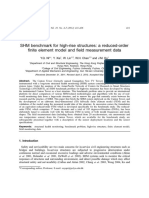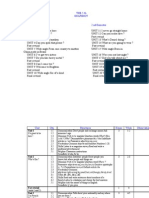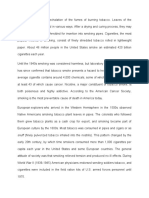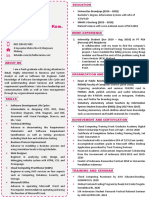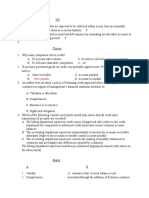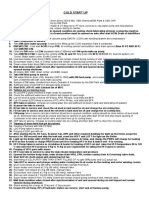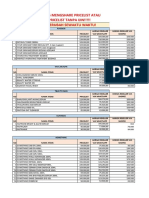Professional Documents
Culture Documents
Assignment 1
Assignment 1
Uploaded by
Afham AhmadOriginal Description:
Copyright
Available Formats
Share this document
Did you find this document useful?
Is this content inappropriate?
Report this DocumentCopyright:
Available Formats
Assignment 1
Assignment 1
Uploaded by
Afham AhmadCopyright:
Available Formats
Assignment #1
Identification Methods for Structural Systems
Modeling of a four story shear frame
The structural system of Fig.1 represents a shear frame model of a building with a tuned mass
damper on its top story. The frame vibrates under the presence of earthquake excitation. Table 1
provides numerical values for the structural properties of the associated elements.
Table 1: Structural parameters.
Story Mass (Mgr) Stiffness (kN/m)
1 100 200000
2 80 150000
TMD 8 30000
Figure 1: The shear frame structure wit the tuned
mass damper on top.
1) Construct the free body diagram and derive the corresponding equation of motion for every
degree-of-freedom. Then bring the derived system of equations in the following matrix form
() + () = () (1)
and provide full description of the associated vectors/matrices.
2) Use MATLABs ode45 function (Runge Kutta method) in order to numerically obtain the
undamped structural response (displacements/velocities/accelerations) to the accelerogram of
the El Centro earthquake [ElCentro.mat file 1st column corresponds to time, 2nd column to
the earthquake].
3) Calculate the natural frequencies (in Hz) and the mode shapes of the structure. Normalize
each mode shape with respect to the element with the maximum absolute value. Plot the
normalized mode shapes (Hint: use MATLAB function eig).
4) Assume that the system is characterized by proportional Rayleigh damping
= +
where and are the mass and stiffness matrices of Eq.1, respectively. Calculate and so
that the first two vibration modes of the frame without the tuned mass damper retain 2%
modal damping. Which are the modal damping values for the combined structure?
5) Form the matrices A, B, C and D of the systems state space representation and create the
corresponding system model in MATLAB [command ss(A,B,C,D)]. Select all displacements,
velocities and accelerations as the output of your state space model.
6) Use MATLAB function lsim to simulate the state space model and obtain the damped
structural response under the same excitation of step 2. Comment on the differences between
the structural responses calculated at step 2 to those calculated here.
7) Apply the Laplace transform and derive qualitative expressions for the transfer functions ()
between the horizontal relative accelerations of each degree-of-freedom and the ground
acceleration.
8) Apply the tf MATLAB command to the state-space model of step 5 and derive the transfer
functions of step 7. Which are the roots of the denominator of each H()? Are these roots
stable? [roots and pzmap MATLAB commands].
9) Use the bodeplot MATLAB command and obtain the Frequency Response Functions (FRFs)
for the quantities of steps 7-8. Make sure that the x-axis of the FRFs is in Hz, the magnitude
units in dB and the phase units in degrees.
10) Using the plotted FRFs, identify the frequencies at which the amplitudes of the responses are
(i) equal to the amplitude of the excitation, (i) one order of magnitude smaller than the one of
the excitation, and (iii) one order of magnitude larger than the one of the excitation.
11) Use amplitude graphs of the FRFs and the half power method in order to calculate the natural
frequencies and the damping ratios of the system and compare with those obtained at steps 3-
4. Comment on the results.
12) Submit your m-code electronically to chatzi@ibk.baug.ethz.ch along with a short report on the
steps and appropriate figures. Use YOURNAME-IMSS-ASSIGMENT 1 as mail subject.
You might also like
- Vibration HW#2Document2 pagesVibration HW#2Narasimha Reddy100% (1)
- Area of Regular PolygonsDocument2 pagesArea of Regular PolygonsFady NagyNo ratings yet
- Limitation Imposed On Structural DesignerDocument2 pagesLimitation Imposed On Structural DesignerdvarsastryNo ratings yet
- Feedcs Exp2Document6 pagesFeedcs Exp2Carl Kevin CartijanoNo ratings yet
- Theory Exam-18Document2 pagesTheory Exam-18mvr20100No ratings yet
- A) Derive Euler - Lagrange Equation For Finding The Equations of Motion For A (10 Marks)Document2 pagesA) Derive Euler - Lagrange Equation For Finding The Equations of Motion For A (10 Marks)Sahil RanaNo ratings yet
- Refrence (QP) 1 20-21Document12 pagesRefrence (QP) 1 20-21UMA MAGESHWARI ANo ratings yet
- Dynamics Response Spectrum Analysis - Shear Plane FrameDocument35 pagesDynamics Response Spectrum Analysis - Shear Plane Frameamrsaleh999No ratings yet
- Mini Problem s2 2023Document5 pagesMini Problem s2 2023Annette TageufoueNo ratings yet
- Tutorial Problems: EI 294772.2 N.MDocument3 pagesTutorial Problems: EI 294772.2 N.MtannuNo ratings yet
- Assignment 4Document2 pagesAssignment 4t23059No ratings yet
- LaibaDocument12 pagesLaibaLaiba YousafNo ratings yet
- Homework # 4Document2 pagesHomework # 4eniNo ratings yet
- MCHE485 Final Spring2015 SolDocument15 pagesMCHE485 Final Spring2015 SolMahdi KarimiNo ratings yet
- Es386 2017Document7 pagesEs386 2017Luke HoganNo ratings yet
- STRL Dynamics M. TechDocument4 pagesSTRL Dynamics M. TechNandeesh SreenivasappaNo ratings yet
- HW2 PDFDocument4 pagesHW2 PDFAshishNo ratings yet
- Bode PlotDocument5 pagesBode PlotAlexandro Andra PizzaroNo ratings yet
- Paper ID (CE404) : Roll No. ...................... Total No. of Questions: 09)Document2 pagesPaper ID (CE404) : Roll No. ...................... Total No. of Questions: 09)anuj sethNo ratings yet
- Implementing Motion Markov Detection On General Purpose Processor and Associative MeshDocument6 pagesImplementing Motion Markov Detection On General Purpose Processor and Associative MeshTuan NguyenNo ratings yet
- Dr. Manzuri Computer Assignment 1: Sharif University of Technology Computer Engineering DepartmentDocument3 pagesDr. Manzuri Computer Assignment 1: Sharif University of Technology Computer Engineering DepartmentsaharNo ratings yet
- Project Fall2015Document5 pagesProject Fall2015AlvinNo ratings yet
- 1112012913dynamics Response Spectrum Analysis PDFDocument33 pages1112012913dynamics Response Spectrum Analysis PDFHectoreRodriguezlNo ratings yet
- Assignment 03 PDFDocument2 pagesAssignment 03 PDFcodieNo ratings yet
- Assignment 3Document2 pagesAssignment 3OsamaZaidNo ratings yet
- Homework 9 - CEE 511 - F19Document23 pagesHomework 9 - CEE 511 - F19John ShottkeyNo ratings yet
- Chapter 8: Generation of Floor Response Spectra and Multiple Support Excitation G. R. Reddy & R. K. VermaDocument14 pagesChapter 8: Generation of Floor Response Spectra and Multiple Support Excitation G. R. Reddy & R. K. VermaDivya Dev C MNo ratings yet
- ME730A - Modal Analysis: Theory and PracticeDocument5 pagesME730A - Modal Analysis: Theory and PracticePankaj KumarNo ratings yet
- Application of Neural Networks To The Seismic Analysis of StructuresDocument11 pagesApplication of Neural Networks To The Seismic Analysis of StructuresRamprasad SrinivasanNo ratings yet
- Modeling and Digital Simulation Case Studies: 3.1 Pre-Lab AssignmentDocument13 pagesModeling and Digital Simulation Case Studies: 3.1 Pre-Lab AssignmentLittle_skipNo ratings yet
- FEEDCS - EXP2 Paule Andrea Christine L.Document11 pagesFEEDCS - EXP2 Paule Andrea Christine L.Carl Kevin CartijanoNo ratings yet
- Seismic Requirement of Power TransformerDocument10 pagesSeismic Requirement of Power TransformerPrashant PuriNo ratings yet
- Dynamics Response Spectrum AnalysisDocument33 pagesDynamics Response Spectrum AnalysisAhmed Gad100% (1)
- 2 - Vibration Isolation PDFDocument3 pages2 - Vibration Isolation PDFAhmad Ayman FaroukNo ratings yet
- Numerical DampingDocument5 pagesNumerical DampingAnonymous yVMG7vDNo ratings yet
- d1) 2DOF (Rev1)Document44 pagesd1) 2DOF (Rev1)chocsoftwareNo ratings yet
- Unit 2 Control SystemDocument75 pagesUnit 2 Control SystemGirish Shankar MishraNo ratings yet
- Are We Ready For ELcentroDocument55 pagesAre We Ready For ELcentroSaikat KabirajNo ratings yet
- 1PTU DOS May 12Document4 pages1PTU DOS May 12skverma5724No ratings yet
- Control System and Feedback: Manuel S. Enverga University FoundationDocument32 pagesControl System and Feedback: Manuel S. Enverga University Foundationlemuel mabilinNo ratings yet
- Ss Jntuk Dec 2015Document4 pagesSs Jntuk Dec 2015giribabukandeNo ratings yet
- Note: No Additional Answer Sheets Will Be Provided.: (An Autonomous Institution)Document3 pagesNote: No Additional Answer Sheets Will Be Provided.: (An Autonomous Institution)Rajesh AnugulaNo ratings yet
- A Torque Cancelling System For Quick-Motion Robots: Daigoro IsobeDocument21 pagesA Torque Cancelling System For Quick-Motion Robots: Daigoro IsobeRavi KhandelwalNo ratings yet
- Three Position ControlDocument4 pagesThree Position ControlMaciejNo ratings yet
- MF2030 Final Exam Solution HT10Document12 pagesMF2030 Final Exam Solution HT10Athul_V_Dev_1688No ratings yet
- Control Lec 02 - 2021 - Course IDocument9 pagesControl Lec 02 - 2021 - Course Iyasa1990No ratings yet
- Homework 6 2020Document2 pagesHomework 6 2020asdfghjklNo ratings yet
- Lab 2cDocument20 pagesLab 2cf2020134037No ratings yet
- Problem Set 1Document2 pagesProblem Set 1Uday RameshNo ratings yet
- Assignment DraftDocument1 pageAssignment DraftjackNo ratings yet
- Structural Integrity Analysis of BridgesDocument16 pagesStructural Integrity Analysis of BridgesKarlNo ratings yet
- EE132 Lab1 OL Vs CLDocument3 pagesEE132 Lab1 OL Vs CLthinkberry22No ratings yet
- Modal Space Sliding-Mode Control of Structures: Earthquake Engng. Struct. Dyn. 27, 1303-1314 (1998)Document12 pagesModal Space Sliding-Mode Control of Structures: Earthquake Engng. Struct. Dyn. 27, 1303-1314 (1998)pippoNo ratings yet
- Lecture 2Document12 pagesLecture 2Syed Hussain Akbar MosviNo ratings yet
- Assignment 1 and 2Document7 pagesAssignment 1 and 2sahulipunku2001No ratings yet
- PS5211-Advanced Power System Simulation LaboratoryDocument121 pagesPS5211-Advanced Power System Simulation LaboratoryKetolearner NaveenNo ratings yet
- Questions 91 1 PDFDocument5 pagesQuestions 91 1 PDFMoj JamaranNo ratings yet
- Asian Journal of Civil Engineering (Building and Housing) Vol. 8Document16 pagesAsian Journal of Civil Engineering (Building and Housing) Vol. 8muhammadyf100% (2)
- From Microstructure Investigations to Multiscale Modeling: Bridging the GapFrom EverandFrom Microstructure Investigations to Multiscale Modeling: Bridging the GapDelphine BrancherieNo ratings yet
- Geotechnical LessonDocument17 pagesGeotechnical LessonAfham AhmadNo ratings yet
- Korneva DariaDocument90 pagesKorneva DariaAfham AhmadNo ratings yet
- Lms-FAQ804 Import SCADAS Xs Data Into TestlabDocument2 pagesLms-FAQ804 Import SCADAS Xs Data Into TestlabAfham AhmadNo ratings yet
- Sadek 1997Document19 pagesSadek 1997Afham AhmadNo ratings yet
- Research Article: Distributed Multiple Tuned Mass Dampers For Wind Vibration Response Control of High-Rise BuildingDocument12 pagesResearch Article: Distributed Multiple Tuned Mass Dampers For Wind Vibration Response Control of High-Rise BuildingAfham AhmadNo ratings yet
- Dynamic Characteristics of Multiple Substructures With Closely Spaced FrequenciesDocument12 pagesDynamic Characteristics of Multiple Substructures With Closely Spaced FrequenciesAfham AhmadNo ratings yet
- SHM Benchmark For High-Rise Structures: A Reduced-Order Finite Element Model and Field Measurement DataDocument16 pagesSHM Benchmark For High-Rise Structures: A Reduced-Order Finite Element Model and Field Measurement DataAfham AhmadNo ratings yet
- Advance Spreadsheet SkillsDocument14 pagesAdvance Spreadsheet SkillsJastine Mico benedictoNo ratings yet
- THE 5 TH SnapshotDocument23 pagesTHE 5 TH SnapshotTurtureanu SilvianaNo ratings yet
- Snuff (Finely Pulverized Tobacco Inhaled Into The Nostrils) - This Pattern Changed by TheDocument15 pagesSnuff (Finely Pulverized Tobacco Inhaled Into The Nostrils) - This Pattern Changed by TheGabriel R. AboNo ratings yet
- Itp ForkliftDocument3 pagesItp ForkliftpandiNo ratings yet
- DPP 01 Mole Concept JH Sir-3571Document8 pagesDPP 01 Mole Concept JH Sir-3571PrädunmaChoudhury100% (3)
- Rayson: Class1 Bc04-Ext Module Btm-222Document10 pagesRayson: Class1 Bc04-Ext Module Btm-222Adrian FlorinNo ratings yet
- Cement Consumer InsightsDocument31 pagesCement Consumer InsightsSuchinto TarafdarNo ratings yet
- Horeca Solo 13 Januari 2022Document15 pagesHoreca Solo 13 Januari 2022ekaandikasariNo ratings yet
- Rathus PSYCH 2e SensationDocument44 pagesRathus PSYCH 2e SensationPatrick Begino50% (2)
- DIY Outdoor Couch: See More Details and Photos HereDocument7 pagesDIY Outdoor Couch: See More Details and Photos HereCláudia BenediniNo ratings yet
- International Financial Management Abridged 10 Edition: by Jeff MaduraDocument16 pagesInternational Financial Management Abridged 10 Edition: by Jeff MaduraHiếu Nhi TrịnhNo ratings yet
- Designing For Clarity Author Bianca WoodsDocument61 pagesDesigning For Clarity Author Bianca WoodsMohammed EL AoulaNo ratings yet
- Sanjay CV (New) - 7Document3 pagesSanjay CV (New) - 7nitinNo ratings yet
- Business EtiquetteDocument11 pagesBusiness EtiquetteSubhadra RamkumarNo ratings yet
- CV - Bella Karina SariDocument1 pageCV - Bella Karina Sariricoardi ansyahNo ratings yet
- Aditing II Q From CH 3,4,5Document2 pagesAditing II Q From CH 3,4,5samuel debebeNo ratings yet
- Office Politics: Are You A Player?Document2 pagesOffice Politics: Are You A Player?Joshua JohnsonNo ratings yet
- Intro To GEIA-STD-0007 Oct 06Document32 pagesIntro To GEIA-STD-0007 Oct 06kaiser777No ratings yet
- 300 MW ThermalPower Plant Cold Start UpDocument4 pages300 MW ThermalPower Plant Cold Start Upsunil481100% (1)
- Answers For Power & DistributionDocument60 pagesAnswers For Power & DistributionkuchowNo ratings yet
- မိုးကုတ်ဓမ္မမှတ်စုDocument70 pagesမိုးကုတ်ဓမ္မမှတ်စုClassic BobbyNo ratings yet
- Disclosure of Subsidiaries With Non-Controlling Interest in Accordance With IFRS 12 Case of MaterialityDocument7 pagesDisclosure of Subsidiaries With Non-Controlling Interest in Accordance With IFRS 12 Case of Materialityabed abusalamehNo ratings yet
- Skwezed EjuiceDocument13 pagesSkwezed Ejuicevapemeisters2No ratings yet
- D H LawrenceDocument12 pagesD H LawrencePhilip Finlay Bryan100% (4)
- Cat World October 2018Document84 pagesCat World October 2018Friedrich NietzscheNo ratings yet
- Dilarang Keras Mengshare Pricelist Atau Merevisi Pricelist Tanpa Ijin!!!!! Harga Bisa Berubah Sewaktu Waktu!Document6 pagesDilarang Keras Mengshare Pricelist Atau Merevisi Pricelist Tanpa Ijin!!!!! Harga Bisa Berubah Sewaktu Waktu!Vivian LieNo ratings yet
- Huawei GSM-R: Future Proof, Flexible and Reliable: Norman FRISCHDocument18 pagesHuawei GSM-R: Future Proof, Flexible and Reliable: Norman FRISCHCharles SedilloNo ratings yet
- Numerical Simulation of A Mathematical Traffic Flow Model Based On A Nonlinear Velocity-Density FunctionDocument23 pagesNumerical Simulation of A Mathematical Traffic Flow Model Based On A Nonlinear Velocity-Density Functionhkabir_juNo ratings yet
- Renal - Goljan SlidesDocument29 pagesRenal - Goljan SlidesJoan ChoiNo ratings yet




